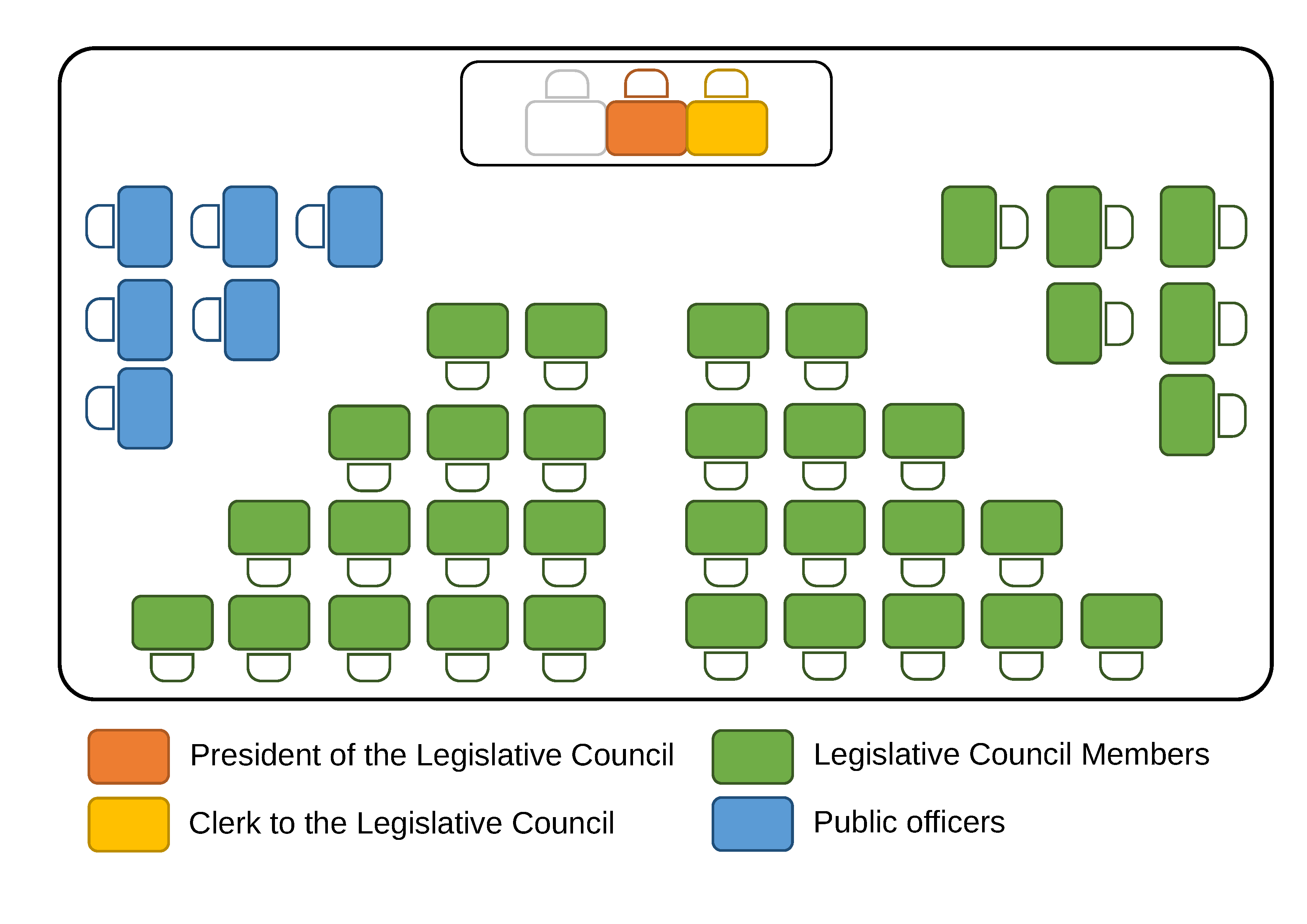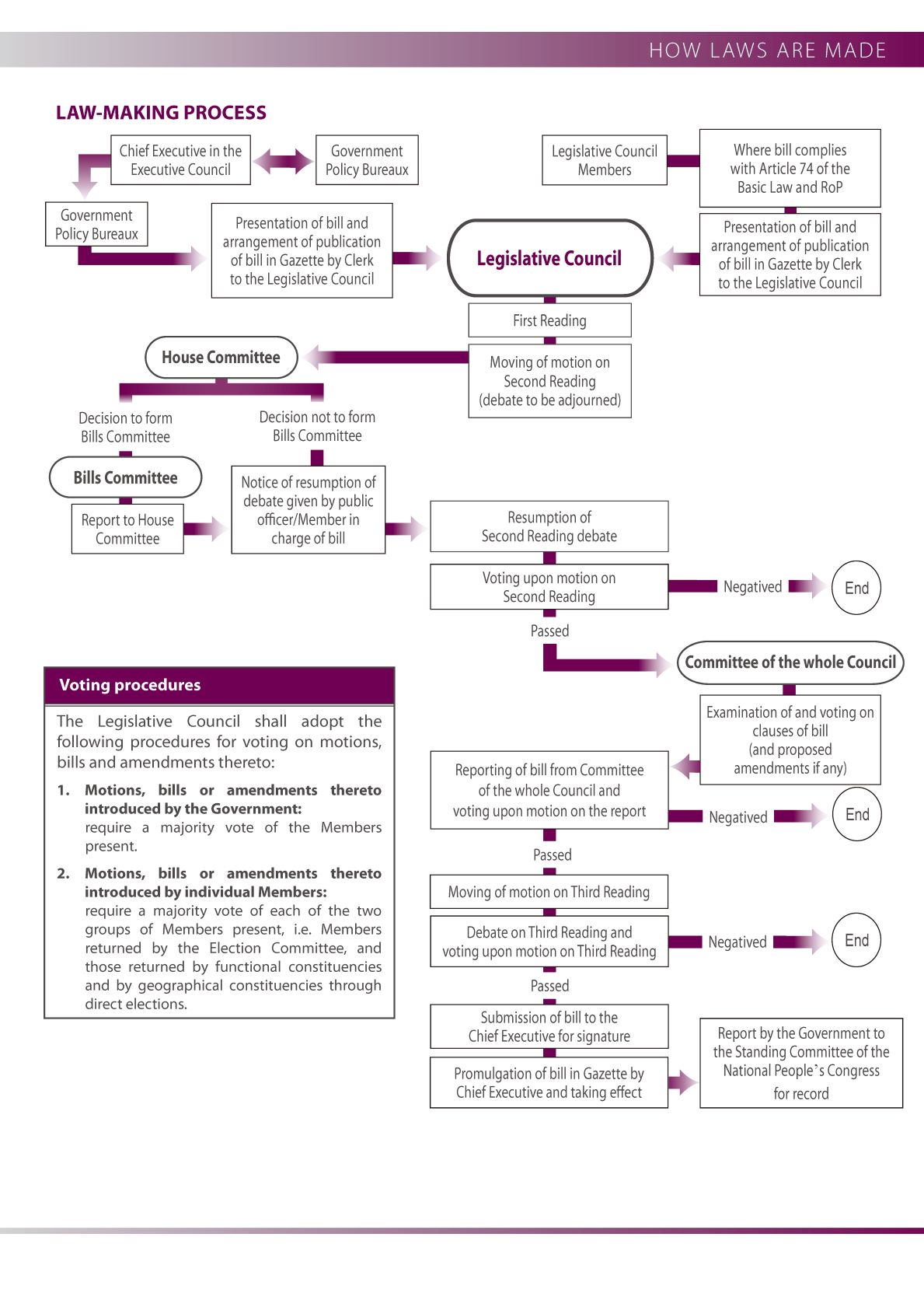Students simulate the law-making process through a role-play.
The Secretariat offers the following bills and scripts for role-play on the passage of mock bills:
For primary schools- “Homework Bill” (script);
- “Air-conditioning System Control Bill” (script); and
- “School Sports Bill” (script);
For secondary schools or above
- “Liquor Advertisements Bill” (script);
- “Street Performance Bill” (script); and
- “Nuclear Power Bill” (script)
Teachers may prepare mock bills for students to debate on and make use of the scripts provided here with due modifications.
Seating arrangement in the classroom should follow the seating plan below:

Total duration for a role-play: 45 minutes
| Time | Duration | Programme (For primary schools) |
Programme (For secondary schools or above) |
|---|---|---|---|
| 00:00 – 00:15 | 15 mins | Teacher briefs students on (1) the law-making process; (2) voting procedures; and (3) the mock bill. | |
| 00:15 – 00:18 | 3 mins | Teachers explain the rules of role-play to students, which include:
|
|
| 00:18 – 00:20 | 2 mins |
|
|
| 00:20 – 00:22 | 2 mins | Apart from the students who act as the President, the Clerk and the public officer, the rest of the students act as Members. |
|
| 00:22 – 00:32 | 10 mins | First Reading and Second Reading debate
|
First Reading and Second Reading debate
|
| Time | Duration | Programme (For primary schools) |
Time | Duration | Programme (For secondary schools or above) |
|---|---|---|---|---|---|
| 00:32 – 00:35 | 3 mins | Voting after debate | 00:32 – 00:34 | 2 mins | Voting after debate |
| 00:35 – 00:38 | 3 mins | Third Reading and voting | 00:34 – 00:39 | 5 mins | Committee of the whole Council |
| 00:38 – 00:41 | 3 mins | Review and feedback * | 00:39 – 00:42 | 3 mins | Third Reading and voting |
| 00:41 – 00:43 | 2 mins | Voting of the best speaker | 00:42 – 00:45 | 3 mins | Review and feedback * |
| 00:43 – 00:45 | 2 mins | Presentation of certificate/award to the best speaker # |
* Review and feedback: Teachers may reiterate that the three-reading procedure is much more complicated in the Legislative Council, and ask students for comments or feelings.
# Presentation of certificate/award to the best speaker:
- Students may vote for the best speaker after feedback session by raising their hands. Teachers may count the votes.
- If time is running short, the best speaker may be selected by teachers.
- Teachers may present either a certificate or an award to the best speaker.
President of the Legislative Council
- The President has to chair and monitor the order throughout the whole Legislative Council Meeting. He/she is the only one who can remain seated during speaking.
- When a Member raises his/her hand to indicate his/her intention to speak, the President should call his/her name before inviting him/her to speak.
- The President has to ensure every Member who raises his/her hand has an opportunity to speak. When all Members have delivered their speeches, the President then calls upon the Members who raise their hands and intend to speak for the second time.
- The President should be good at time-control of the meeting and should monitor the speaking time for each Member.
- The President has to monitor the voting procedures and subsequently announce whether the motion is passed.
Clerk to the Legislative Council
- The Clerk shall speak standing and read out the short title of the bill during the “First Reading”, “Second Reading” and “Third Reading” (if the bill is passed).
- The Clerk does not have the right to vote in the Legislative Council meeting.
- The Clerk has to count the total number of students (i.e. the President and Members present), excluding himself/herself and the public officer before voting. He/she has to count the number of students required for the passage of the bill.
- The Clerk shall report the voting results to the President.
Public officer
- The public officer shall speak standing.
- The public officer should introduce the principle and merits of the bill as well as seek support from Members.
- The public officer does not have the right to vote in the Legislative Council meeting.
Legislative Council Members
- Every Member must raise his/her hand to indicate his/her intention to speak. He/she should wait for the President to call his/her name before speaking.
- Every Member shall speak standing.
- All Members have the right to vote in the Legislative Council meeting.
- A minimum of 15 persons to a maximum of 45 persons for a role-play.
- Teachers arrange students to be seated according to their assigned roles.
- Students take turns to speak according to their assigned roles and scripts.
- In addition to the scripts for the President, the Clerk and the public officer, scripts for five Members have also been prepared by the Secretariat.
- To create a lively atmosphere for the debate, teachers may encourage students who act as Members to give their views freely.
- After all students who act as Members have delivered their speeches, they will vote on the bill to decide whether it is passed or not.
Students have to follow the rules below throughout the role-play, which have been made in reference to the “Rules of Procedure” of the Legislative Council:
-
Conduct
- Except the President, every participant (including Members, the Clerk and the public officer) shall speak standing.
- While a Member is speaking, all other Members shall remain silent and make no improper interruptions.
-
Speaking
- Members shall raise their hands to indicate their intention to speak. They shall speak standing after being called upon by the President, to whom their observations shall be addressed. Members shall be seated after speaking.
- If two or more Members indicate their intention to speak at the same time, the President shall decide the order of speaking and call upon the Members to speak in turn.
- No Member may speak more than once during the debate on Second Reading of a bill or on a motion (teachers may decide on the number of times that a Member may speak in the light of the debating atmosphere and time available).
- Members shall not, without permission of the President, make a speech lasting more than XX minutes on a motion (speaking time allowed for each Member is subject to the number of participants in the debate and time available for the role-play).
-
Voting
- The passage of a bill introduced by the Government shall require a majority vote of Members present, including the President. For example, if there are 40 Members in a role-play, the passage of the bill shall require at least 21 votes from Members in favour of it.
- The President shall call upon those Members who are in favour of the bill to raise their hands. The Clerk shall assist in counting the votes. The President then calls upon those who are against the bill to raise their hands. The Clerk shall report the voting results to the President. The President shall subsequently announce whether the bill is passed or not.
- The Clerk and the public officer are not allowed to vote.
